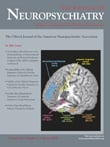Topiramate-Induced Palinopsia
To the Editor: Topiramate is a fructopyranose derivative that has proven effective in the treatment of several psychiatric conditions, such as bulimia nervosa, 1 borderline personality disorder, 2 and alcohol abuse. 3 Although its mechanism of action is not fully understood, topiramate is known to enhance γ-aminobutyric acid (GABA) responses, impair AMPA/kainate glutamate receptors, suppress high-frequency action potential firing, and inhibit carbonic anhydrase. 4 Topiramate’s most common adverse effects include somnolence, ataxia, dizziness, psychomotor slowing, speech disorders, and paresthesias. 5 We report an unusual visual disturbance in one patient taking topiramate.
Case Report
Ms. A, a 35-year-old obese woman with cyclothymic disorder, bulimia nervosa, and borderline personality disorder, sought psychiatric assessment as a part of an evaluation for intended bariatric surgery. She had a history of intermittent, 1-week episodes of depressed and irritable mood, insomnia, binging and purging behaviors, and increased sexual drive. These symptoms were regularly followed by a few days of increased self-esteem, heightened activity, and alcohol abuse. Ms. A had a history of sexual abuse at age 6. She received combined psychotherapy and pharmacotherapy. Soon after an initial trial of topiramate and clonazepam, Ms. A reported an improvement of her insomnia, but, on the fourth day of treatment, developed affective instability and disinhibition. These side effects prompted the discontinuation of clonazepam. To keep her insomnia and other impulsive behaviors under control, topiramate was gradually increased to 100 mg/day.
Soon afterward, Ms. A reported seeing “picture in picture” images, like she was in a “discotheque,” or in a place with stroboscopic lights. Those persistent “frozen pictures” faded away after a few seconds. The phenomenon repeated itself with most moving objects. Although this side effect occurred several times during a day, she did not describe the experience as anxiety-provoking and preferred not to withdraw the medication. She had a normal neurological examination and no history of seizures or substance abuse disorders other than alcohol. She was not taking any other medications at the time of the phenomenon herein described.
Palinopsia (Greek palin , again, and opsis , vision) is the symptom of persistent or recurrent visual images, following removal of the exciting stimulus. 6 There are several potential medical etiologies for palinopsia, including seizures, cerebrovascular diseases, brain neoplasms, and eye or optic nerve disease. 7 The temporal relationship between the occurrence of the palinopsia and the administration of topiramate seen in our patient suggests that this drug might have been the trigger for the observed phenomenon. In fact, there are other recent reports of topiramate-induced palinopsia. 8
Comment
We can only speculate on the pharmacodynamic mechanisms underlying topiramate-induced palinopsia. Several drugs that have been associated with palinopsia share a 5-HT 2 -receptor activity, including LSD, 9 trazodone, 10 nefazodone, 11 risperidone, 12 and, more recently, mirtazapine. 13 Although no systematic report on the serotonergic profile of topiramate has been performed to date, it has been suggested that the weight loss associated with this drug may be ascribed, directly or indirectly (via first or second messenger systems), to an action in the 5-HT 2C receptors. 14 Therefore, our patient’s visual disturbance could well be another indirect evidence of a putative serotonergic activity associated with topiramate.
1 . Nickel C, Tritt K, Muehlbacher M, et al: Topiramate treatment in bulimia nervosa patients: a randomized, double-blind, placebo-controlled trial. Int J Eat Disord 2005; 38:295–300Google Scholar
2 . Loew TH, Nickel MK, Muehlbacher M, et al: Topiramate treatment for women with borderline personality disorder: a double-blind, placebo-controlled study. J Clin Psychopharmacol 2006; 26:61–66Google Scholar
3 . Johnson BA, Ait-Daoud N, Akhtar FZ, et al: Oral topiramate reduces the consequences of drinking and improves the quality of life of alcohol-dependent individuals: a randomized controlled trial. Arch Gen Psychiatry 2004; 61:905–912Google Scholar
4 . Schneiderman JH: Topiramate: pharmacokinetics and pharmacodynamics. Can J Neurol Sci 1998; 25:S3–5Google Scholar
5 . Jones MW: Topiramate: safety and tolerability. Can J Neurol Sci 1998; 25:S13–5Google Scholar
6 . Meadows JC, Munro SS. Palinopsia. J Neurol Neurosurg Psychiatry 1977; 40:5–8Google Scholar
7 . Smith PE, Shah P, Sharpe J, et al: Palinopsia. Lancet 2003; 361:1098Google Scholar
8 . Evans RW: Reversible palinopsia and the Alice in Wonderland syndrome associated with topiramate use in migraineurs. Headache 2006; 46:815–818Google Scholar
9 . Sunness JS: Persistent afterimages (palinopsia) and photophobia in a patient with a history of LSD use. Retina 2004; 24:805Google Scholar
10 . Hughes MS, Lessell S: Trazodone-induced palinopsia. Arch Ophthalmol 1990; 108:399–400Google Scholar
11 . Faber RA, Benzick JM: Nefazodone-induced palinopsia. J Clin Psychopharmacol 2000; 20:275–276Google Scholar
12 . Lauterbach EC, Abdelhamid A, Annandale JB: Posthallucinogen-like visual illusions (palinopsia) with risperidone in a patient without previous hallucinogen exposure: possible relation to serotonin 5HT2 a receptor blockade. Pharmacopsychiatry 2000; 33:38–41 Google Scholar
13 . Ihde-Scholl T, Jefferson JW: Mirtazapine-associated palinopsia. J Clin Psychiatry 2001; 62:373Google Scholar
14 . Dursun SM, Devarajan S: Accelerated weight loss after treating refractory depression with fluoxetine plus topiramate: possible mechanisms of action? Can J Psychiatry 2001; 46:287–288Google Scholar



